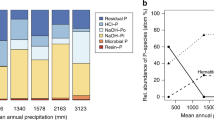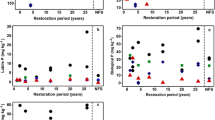Abstract
Phosphorus availability in soils is controlled by both the sizes of P pools and the transformation rates among these pools. Rates of gross P mineralization and immobilization are poorly known due to the limitations of available analytical techniques. We developed a new method to estimate P transformation rates in three forest soils and one grassland soil representing an Alfisol, an Ultisol, and Andisol, and a Mollisol. Three treatments were applied to each soil in order to separate the processes of mineral P solubilization, organic P mineralization, and solution P immobilization. One set of soils was retained as control, a second set was irradiated with Γ-rays to stop microbial immobilization, and a third was irradiated and then autoclaved, also stop phosphatase activity. All three sets of samples were then incubated with anion exchange resin bags under aerobic conditions. Differences in resin P among the three treatments were used to estimate gross P mineralization and immobilization rates. Autoclaving did not affect resin-extractable P in any of the soils. Radiation did not alter resin-extractable P in the forest soils but increased resin-extractable P in the grassland soil. This increase was corrected in the calculation of potential P transformation rates. Effects of radiation on phosphatase activity varied with soils but was within 30% of the original values. Rates of P gross mineralization and immobilization ranged from 0.6–3.8 and 0–4.3 mg kg-soil-1 d-1, respectively, for the four soils. The net rates of solubilization of mineral P in the grassland soil were 7–10 times higher than the rates in forest soils. Mineralization of organic P contributed from 20–60% of total available P in the acid forest soils compared with 6% in the grassland soil, suggesting that the P mineralization processes are more important in controlling P availability in these forest ecosystems. This new method does not require an assumption of equilibrium among P pools, and is safer and simpler in operation than isotopic techniques.
Similar content being viewed by others
References
Amer F, Bouldin D R, Black C A and Duke F R 1955 Characterization of soil phosphorus by anion exchange resin adsorption and 32P-equilibration. Plant and Soil 6, 391–408.
Balmer W E, Owens E G and Jorgenson J R 1975 Effects of various spacings on loblolly pine growth 15 years after planting. USDA Forest Service Research Note SE-211, Asheville, NC.
Binkley D and Sollins P 1990 Factors determining differences in soil pH in adjacent conifer and alder-conifer stands. Soil Sci. Soc. Am. J. 54, 1427–1433.
Binkley D, Dunkin K A, DeBell D and Ryan M G 1992 Production and nutrient cycling in mixed plantations of Eucalyptus and Albizia in Hawaii. For. Sci. 38, 393–408.
Binkley D, Valentine D, Wells C and Valentine U 1989 An empirical analysis of the factors contributing to 20-year decrease in soil pH in an old-field plantation of loblolly pine. Biogeochemistry 8, 39–54.
Brookes P C, Powlson D S and Jenkinson D S 1984 Phosphorus in the soil microbial biomass. Soil Biol. Biochem. 16, 169–175.
Cole C V, Innis G S and Stewart J W B 1977 Simulation of phosphorus cycling in semiarid grasslands. Ecology 58, 1–15.
DeBell D S, Whitesell C D and Schubert T H 1989 Using N-fixing Albizia to increase growth of Eucalyptus plantations in Hawaii. For. Sci. 35, 64–75.
Dissing Nielsen J and Eiland F 1980 Investigations on the relationship between P-fertility, phosphatase activity and ATP content in soil. Plant and Soil 57, 95–103.
Hedley M J and Stewart J W B 1982 Method to measure microbial phosphate in soils. Soil Biol. Biochem. 14, 277–385.
Hedley M J, Stewart J W B and Chauhan B S 1982 Changes in inorganic soil phosphorus fractions induced by cultivation practices and by laboratory incubations. Soil Sci. Soc. Am. J. 46, 970–976.
Hook P B, Burke I C and Lauenroth W K 1991 Heterogeneity of soil and plant N and C associated with individual plants and openings in North American shortgrass steppe. Plant and Soil 138, 275–283.
Lajtha K and Schlesinger W H 1988 The biogeochemistry of phosphorus cycling and phosphorus availability along a desert soil chronosequence. Ecology 69, 24–39.
Lindsay W L 1979 Chemical Equilibria in Soils. Wiley, New York.
McAuliffe C D, Hall N S, Deal L A and Hendricks S B 1948 Exchange reactions between phosphates and soils: Hydroxylic surfaces of soil minerals Soil Sci. Soc. Am. Proc. 12, 119–123.
Murphy J and Riley J P 1962 A modified single solution method for the determination of phosphate in natural waters. Ana. Chim. Acta 26, 31–36.
Rhoades C 1991 Factors influencing soil pH beneath Eucalyptus and Albizia plantations. M.S. thesis. Colorado State University, Fort Collins, CO.
SAS Inc. 1987 SAS guide for personal computers. 6th Edition. Cary, NC.
Sanyal S K and DeDatta S K 1991 Chemistry of phosphorus transformations in soil. Adv. Soil Sci. 16, 1–120.
Sibbesen E 1977 A simple ion-exchange resin procedure for extracting plant-available elements from soil. Plant and Soil 46; 665–669.
Sparrow A H, Underbrink A G and Sparrow R C 1967 Chromosomes and cellular radiosensitivity. I. The relationship of D 0 to chromosome volume and complexity in seventy-nine different organisms. Rad. Res. 32, 915–945.
Tabatabai M A and Bremner J A 1969 Use of p-nitrophenyl phosphate for assay of soil phosphatase activity. Soil Biol. Biochim. 1, 301–307.
Trasar-Cepeda M C and Carballas T 1991 Liming and the phosphatase activity and mineralization of phosphorus in an andic soil. Soil Biol. Biochem. 23, 209–215.
Walbridge M R and Vitousek P M 1987 Phosphorus mineralization potentials in acid organic soils: Processes affecting 32PO4 3- isotope dilution measurements. Soil Biol. Biochem. 19, 709–717.
Walbridge M R, Richardson C J and Swank W T 1991 Vertical distribution of biological and geochemical phosphorus subcycles in two southern Appalachian forest soils. Biogeochemistry 13, 61–85.
Zou X, Binkley D and Caldwell B in review Tree species effects on phosphorus biogeochemistry in forest soils of Oregon and Hawaii. Ecology (submitted).
Author information
Authors and Affiliations
Rights and permissions
About this article
Cite this article
Zou, X., Binkley, D. & Doxtader, K.G. A new method for estimating gross phosphorus mineralization and immobilization rates in soils. Plant Soil 147, 243–250 (1992). https://doi.org/10.1007/BF00029076
Received:
Issue Date:
DOI: https://doi.org/10.1007/BF00029076




